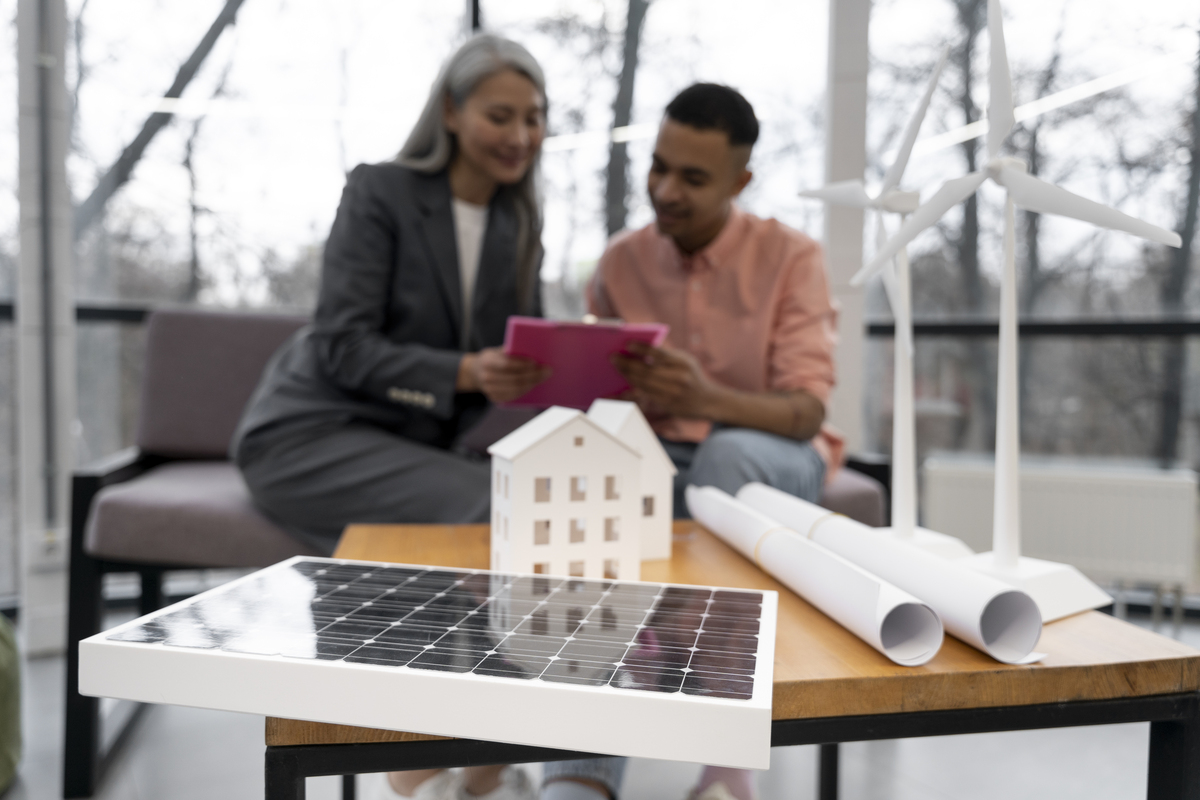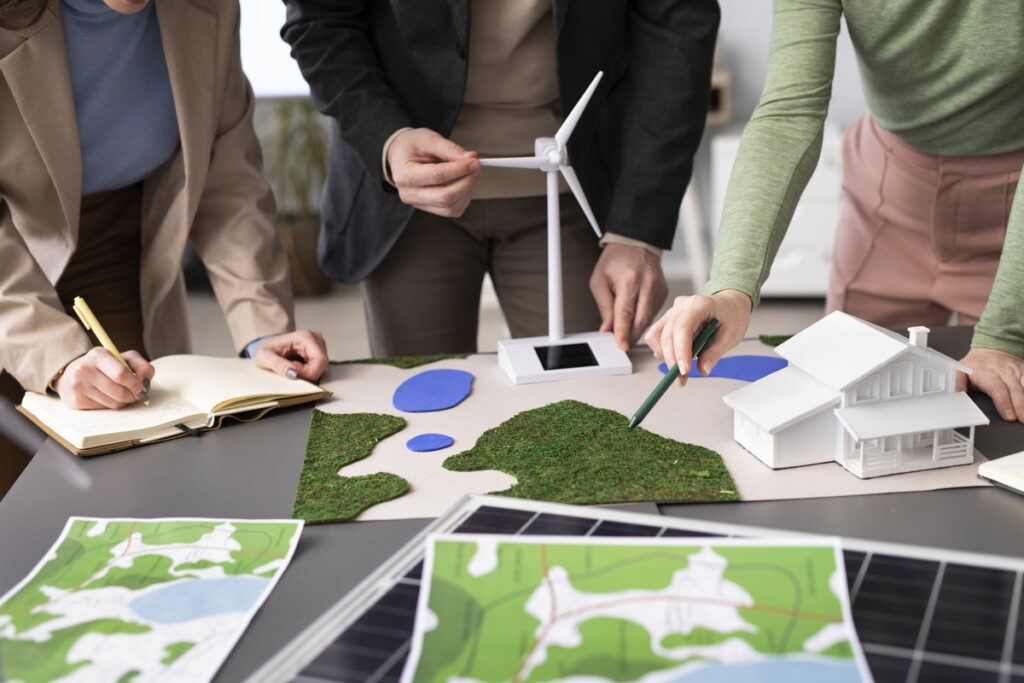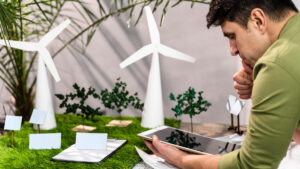The construction industry stands at a critical juncture in the fight against climate change impact on buildings and construction. As the built environment accounts for a staggering 39% of global carbon emissions. As societies strive to transition towards a more sustainable future, the concepts of carbon-neutral and net-zero construction have emerged as pivotal strategies to mitigate the environmental impact of buildings.
According to recent statistics, buildings are responsible for 36% of total energy consumption and 39% of CO2 emissions globally, underscoring the urgent need for transformative action in the construction sector. Carbon-neutral construction seeks to achieve a balance between carbon emissions produced and those removed or offset, while net-zero construction aims to minimize energy consumption and maximize renewable energy generation.
Both approaches represent innovative responses to the pressing challenges of climate change, offering opportunities to reduce greenhouse gas emissions, enhance energy efficiency, and promote resilience in the face of environmental uncertainties. In this article, we delve into the principles, strategies, challenges, and opportunities associated with carbon-neutral and net-zero construction, exploring the latest trends and innovations shaping the future of sustainable building practices.
Table of Contents
Overview of Carbon Neutral Construction
Carbon neutral construction represents a fundamental shift in the way buildings are designed, constructed, and operated to minimize their carbon footprint in construction. At its core, carbon neutrality in construction aims to reduce or offset the greenhouse gas emissions associated with a building’s lifecycle, including its construction, operation, and eventual demolition. This approach is grounded in the recognition that buildings are significant contributors to global carbon emissions, accounting for nearly 40% of total energy-related CO2 emissions.
To achieve carbon neutrality, several key principles are typically employed. Firstly, designers prioritize energy efficiency and renewable energy sources to minimize the building’s operational emissions. This often involves incorporating high-performance insulation, energy-efficient HVAC systems, and solar panels or wind turbines to generate on-site renewable energy. Additionally, architects and engineers may opt for passive design strategies that harness natural light and ventilation to reduce the need for artificial heating, cooling, and lighting.
Beyond operational emissions, carbon neutral construction also addresses emissions associated with materials and construction processes. This includes sourcing sustainable materials with lower embodied carbon, such as recycled or locally sourced materials, as well as reducing waste and optimizing construction techniques to minimize energy-intensive processes.
Suggested article to read: Decarbonizing Construction; A Sustainable Future Ahead (2025 Solution)
Furthermore, carbon neutrality often entails implementing carbon offset measures to compensate for any remaining emissions that cannot be feasibly eliminated. This may involve investing in projects that remove or sequester carbon from the atmosphere, such as reforestation initiatives or carbon capture and storage technologies.
Examples of carbon-neutral buildings abound worldwide, showcasing the feasibility and benefits of this approach. From innovative skyscrapers to eco-friendly residential developments, these projects demonstrate that carbon neutrality is not only achievable but also economically viable and aesthetically appealing. As the urgency of addressing climate change grows, carbon neutral construction is poised to play a pivotal role in creating a more sustainable built environment for future generations.

Overview of Net Zero Construction
Net-zero construction represents a groundbreaking approach to building design and operation, aiming to minimize the carbon footprint of buildings by ensuring that their energy consumption is fully offset by renewable energy generation. Unlike traditional buildings that rely heavily on fossil fuels for heating, cooling, and electricity, net-zero buildings strive to achieve a balance between energy consumption and renewable energy production, resulting in zero net energy consumption over the course of a year.
At the heart of net-zero construction is a focus on energy efficiency and renewable energy integration. Designers prioritize energy-efficient building materials, insulation, windows, and HVAC systems to reduce energy demand. Passive design strategies, such as orientation, shading, and natural ventilation, are also utilized to optimize thermal comfort and minimize the need for mechanical heating and cooling.
Renewable energy generation plays a central role in achieving net-zero status. Buildings often incorporate solar panels, wind turbines, or geothermal systems to generate clean, renewable energy on-site. These renewable energy sources harness the power of sunlight, wind, or heat from the earth to provide electricity, heating, and cooling, thereby reducing reliance on grid-supplied energy generated from fossil fuels.
Suggested article to read: Reduce Carbon Emission in Construction; Ultimate Guide in 2025
Net-zero construction extends beyond operational energy to address embodied carbon emissions associated with materials and construction processes. Builders prioritize low-carbon materials, such as recycled content, sustainably sourced wood, and eco-friendly alternatives to traditional building materials. Additionally, construction techniques are optimized to minimize waste and energy-intensive processes, further reducing the carbon footprint of the building.
The benefits of net-zero construction are manifold. Not only does it help combat climate change by significantly reducing greenhouse gas emissions, but it also offers economic advantages through lower energy bills and increased property value. Moreover, net-zero buildings provide occupants with a healthier and more comfortable indoor environment, characterized by improved air quality, thermal comfort, and daylighting.
While challenges such as upfront costs and technical complexities exist, the momentum behind net-zero construction continues to grow as governments, businesses, and individuals recognize the urgent need to transition to a more sustainable built environment. With continued innovation, collaboration, and investment, net-zero construction has the potential to revolutionize the way buildings are designed, constructed, and operated, paving the way for a more sustainable and resilient future.
Suggested article to read: Building Decarbonization; 2025 Guide
Comparison
Carbon neutral construction and net-zero construction share the common goal of mitigating the environmental impact of buildings, particularly in terms of carbon emissions. However, they differ in their approaches and specific objectives. Here’s a comparison between the two:
Goal:
- Carbon Neutral Construction: The primary aim of carbon-neutral construction is to achieve a balance between the carbon emissions produced and the carbon emissions removed or offset, encompassing the entire lifecycle of the building.
- Net Zero Construction: Net-zero construction focuses on achieving zero net energy consumption, where the total amount of energy used by the building on an annual basis is equal to the amount of renewable energy generated on-site or off-site.
Scope:
- Carbon Neutral Construction: Addresses both operational and embodied carbon emissions associated with the building’s construction, operation, and eventual demolition. It emphasizes reducing emissions as much as possible and offsetting any remaining emissions through carbon sequestration or other means.
- Net Zero Construction: Primarily focuses on operational energy consumption, aiming to minimize energy demand through efficiency measures and offsetting the remaining energy use with renewable energy generation. It typically does not directly address embodied carbon emissions but may indirectly encourage the use of low-carbon materials and construction techniques.
Strategies:
- Carbon Neutral Construction: Emphasizes energy efficiency, use of renewable energy, and carbon offsetting measures. It incorporates a holistic approach that considers the entire lifecycle of the building, from design and construction to operation and end-of-life.
- Net Zero Construction: Prioritizes energy efficiency measures such as insulation, passive design, and high-performance building systems to minimize energy demand. It integrates renewable energy systems like solar panels, wind turbines, or geothermal heat pumps to generate clean energy on-site or procure it from off-site sources.
Focus:
- Carbon Neutral Construction: Places equal importance on reducing both operational and embodied carbon emissions, recognizing the significance of materials and construction processes in addition to building operations.
- Net Zero Construction: Primarily concentrates on minimizing operational energy consumption and maximizing renewable energy generation, with less emphasis on addressing embodied carbon emissions.
Impact:
- Carbon Neutral Construction: Aims to achieve carbon neutrality across the entire building lifecycle, making a broader impact on reducing greenhouse gas emissions associated with the built environment.
- Net Zero Construction: Focuses on reducing energy consumption and promoting renewable energy adoption, contributing to energy independence, resilience, and reducing operational emissions.
In summary, while both carbon-neutral construction and net-zero construction share the overarching goal of reducing the environmental impact of buildings, they differ in their scope, strategies, and specific objectives. Carbon-neutral construction takes a holistic approach that addresses both operational and embodied carbon emissions, while net-zero construction primarily focuses on achieving zero net energy consumption through energy efficiency and renewable energy integration. Ultimately, the choice between the two approaches may depend on factors such as project goals, priorities, and feasibility.

Current Trends and Innovations
In the realm of sustainable construction, several current trends and innovations are reshaping the industry, driving progress towards carbon neutrality and net-zero goals. Here are some notable examples:
Advanced Building Materials
- Low-Carbon Concrete: Innovations in concrete production aim to reduce the carbon footprint of this widely used construction material by incorporating alternative binders, such as fly ash or slag, and optimizing mix designs to lower CO2 emissions.
- Mass Timber Construction: Engineered wood products like cross-laminated timber (CLT) and glue-laminated timber (glulam) are gaining popularity for their sustainability, speed of construction, and carbon sequestration properties, offering a renewable alternative to traditional building materials.
Suggested article to read: Smart Materials in Buildings; 2025 Guide
Smart and Efficient Building Systems
- Building Energy Management Systems (BEMS): These advanced systems integrate sensors, controls, and data analytics to optimize building performance, improve energy efficiency, and reduce operational costs by monitoring and adjusting HVAC, lighting, and other systems in real-time.
- Passive House Design: Inspired by the Passive House standard, buildings designed with passive strategies prioritize airtight construction, high levels of insulation, and passive heating and cooling techniques to drastically reduce energy demand and achieve exceptional comfort and indoor air quality.
Suggested article to read: Construction HVAC Systems; Ultimate Guide for 2025
Renewable Energy Integration
- Building-Integrated Photovoltaics (BIPV): Integrating solar panels directly into building materials such as roofs, facades, or windows enables seamless energy generation while enhancing aesthetics and architectural design.
- Energy Storage Solutions: Advancements in battery technology, coupled with declining costs, are enabling the integration of energy storage systems into buildings, allowing for increased utilization of renewable energy and grid independence.
Suggested article to read: Importance of Energy Efficiency in Buildings
Circular Economy in Construction
- Building Reuse and Adaptive Reuse: Rather than demolishing existing structures, the focus is shifting towards repurposing and renovating buildings to extend their lifespan, reduce waste, and conserve resources.
- Material Recycling and Upcycling: Embracing circular economy principles, designers and manufacturers are exploring innovative ways to recycle construction waste and repurpose materials, such as transforming reclaimed wood into flooring or furniture.
Data-Driven Design and Construction
- Building Information Modeling (BIM): BIM technology facilitates collaborative design and construction processes by creating digital representations of buildings, enabling stakeholders to visualize, simulate, and optimize performance from conception to operation.
- Predictive Analytics and Machine Learning: By leveraging data analytics and machine learning algorithms, construction teams can predict and optimize building performance, energy usage, and maintenance schedules, leading to more efficient and sustainable outcomes.
Green Building Certifications and Standards
- LEED v4.1 and LEED Zero: The latest version of the Leadership in Energy and Environmental Design (LEED) rating system emphasizes performance-based metrics and offers a Zero Carbon certification for buildings that achieve net-zero carbon emissions.
- WELL Building Standard: Focused on enhancing occupant health and well-being, the WELL Building Standard provides guidelines and certifications for creating healthy indoor environments through features like air quality management, daylighting, and biophilic design.
These trends and innovations represent a collective effort to transform the construction industry towards more sustainable, resilient, and environmentally responsible practices. By embracing these advancements, stakeholders can contribute to the creation of healthier, more efficient, and carbon-neutral built environments for future generations.
Suggested article to read: Sustainable Construction Technology; Ultimate Guide in 2025
Challenges and Opportunities
In the journey towards carbon-neutral and net-zero construction, several challenges must be addressed, but these challenges also present opportunities for innovation and progress. Here’s a closer look at some of the key challenges and opportunities:
Challenges
- Cost Implications: The upfront costs of implementing sustainable construction practices, such as integrating renewable energy systems or using low-carbon materials, can be higher than conventional methods, posing financial barriers for some projects.
- Technical Complexity: Designing and constructing carbon-neutral or net-zero buildings requires specialized knowledge and expertise in areas such as energy modeling, passive design strategies, and renewable energy integration, which may be lacking in the industry.
- Regulatory Hurdles: Inconsistent or inadequate building codes and regulations may hinder the adoption of sustainable building practices, making it challenging for developers to meet ambitious sustainability goals without clear guidance or incentives.
- Supply Chain Constraints: Limited availability of sustainable building materials and technologies, as well as fragmented supply chains, can pose challenges in sourcing and procuring environmentally friendly materials at scale.
- Perception and Awareness: Despite growing awareness of environmental issues, there may still be resistance or skepticism within the construction industry and among stakeholders regarding the feasibility or benefits of carbon-neutral and net-zero construction.
Opportunities
- Innovation and Technology: Advances in construction technologies, materials science, and digital tools present opportunities to develop more efficient and sustainable building solutions, driving down costs and improving performance.
- Financial Incentives: Government incentives, grants, tax credits, and financing mechanisms can help offset the upfront costs of sustainable construction and make it more economically viable for developers and building owners.
- Collaboration and Knowledge Sharing: Collaboration among stakeholders, including architects, engineers, contractors, developers, policymakers, and researchers, fosters knowledge sharing and best practices exchange, accelerating innovation and progress.
- Market Demand: Increasing consumer awareness and demand for sustainable buildings, coupled with regulatory requirements and corporate sustainability commitments, create market opportunities for developers and builders who prioritize environmental performance.
- Resilience and Risk Mitigation: Sustainable buildings are often more resilient to climate change impacts, such as extreme weather events and resource scarcity, offering long-term benefits and risk mitigation for building owners and communities.
- Job Creation and Economic Growth: The transition to sustainable construction practices generates new job opportunities in green building design, construction, manufacturing, and related industries, contributing to economic growth and workforce development.
By addressing these challenges and seizing opportunities, stakeholders can overcome barriers to carbon-neutral and net-zero construction and accelerate the transition towards a more sustainable and resilient built environment. Collaboration, innovation, and concerted action across the industry are essential to realizing the full potential of sustainable construction and achieving meaningful progress towards global climate goals.
Conclusion
In conclusion, the pursuit of carbon-neutral and net-zero construction marks a transformative shift in the way we conceive, design, and build our built environment. Both approaches represent innovative responses to the urgent need for sustainable development, driven by the imperative to mitigate climate change and reduce our ecological footprint. Carbon-neutral construction addresses the full lifecycle impact of buildings, emphasizing energy efficiency, renewable energy integration, and carbon offsetting measures. On the other hand, net-zero construction focuses on achieving zero net energy consumption through efficient building systems and renewable energy generation.
While each approach has its unique strategies and objectives, they share a common goal of advancing environmental stewardship and fostering resilience in the face of climate challenges. Moreover, current trends and innovations in sustainable construction, from advanced building materials to data-driven design and circular economy practices, offer promising avenues for progress and transformation.
However, these efforts are not without challenges, including cost implications, technical complexity, regulatory hurdles, and supply chain constraints. Yet, these challenges also present opportunities for innovation, collaboration, and market-driven solutions. By addressing these challenges and seizing opportunities, stakeholders can accelerate the transition towards a more sustainable and resilient built environment, ensuring a healthier, more prosperous future for generations to come. Collaboration, innovation, and concerted action across the industry are essential to realizing the full potential of sustainable construction and achieving meaningful progress towards global climate goals.
Suggested article for reading:
What are SDGs in Construction? 2025 Guide
Top 7 Reusable Materials in Construction; 2025 Review
Resources:
World Green Building Council | wsp.com | TNO | One Click LCA | International Finance Corporation
For all the pictures: Freepik





